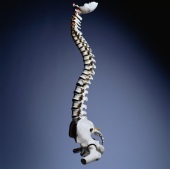
TUESDAY, June 9, 2015 (HealthDay News) — While the overall rate of traumatic spinal cord injuries was stable from 1993 to 2012, an increasing number of older Americans have experienced this injury, a new study finds.
“Spinal cord injury is a catastrophic injury that often results in permanent disability,” said lead researcher Dr. Nitin Jain, an associate professor of physical medicine and rehabilitation at Vanderbilt University School of Medicine in Nashville, Tenn.
Injuries to the spinal cord can cause paralysis as well as permanent changes in strength, sensation and other functions.
Falls are the major cause of these injuries among older adults, Jain said. In addition, deaths from spinal cord injuries remain high, especially in older patients.
“These problems are likely to increase with our aging population,” he said. “Efforts to understand and prevent falls in elderly persons is a public health priority.”
The report was published June 9 in JAMA.
For the study, Jain’s team collected data on more than 63,000 U.S. patients with acute traumatic spinal cord injury.
They found that the number of spinal cord injuries increased from nearly 2,700 in 1993 to almost 3,400 in 2012. However, the rate of injuries, which is the number of cases per total U.S. population, remained stable. In 1993, the rate of spinal cord injuries was 53 cases per 1 million people. In 2012, it was 54 cases per million, the study revealed.
Although the overall rate of spinal cord injury remained constant, the rate in young males — between ages 16 and 24 — went from 144 per million to 87 per million over the decade. In females of the same age, the study found the rate went from 42 per million in 1993 to 27 per million in 2012.
The study authors suspect that public education, improved motor vehicle safety features,
stricter safety belt laws, as well as stricter drunk driving laws and enforcement of those laws may have contributed to the decline in spinal cord injuries in young people.
But the news wasn’t good for all age groups.
Older men — those between 65 and 74 — saw a large increase in their rate of spinal cord injuries — from 84 per million to 131 per million over the study period. The rate in women of the same age went from 32 per million to 53 per million, according to the study.
Among all Americans 65 and older, the number of spinal cord injury from falls increased significantly. It went from 28 percent in 1997-2000 to 66 percent in 2010-2012, the researchers found.
The number of deaths in hospitals from spinal cord injury increased from 6.6 percent in 1993-1996 to 7.5 percent by 2010-2012. But among those 85 and older, deaths decreased significantly. In 1993-1996, the death rate from spinal cord injury for older people was 24 percent. By 2010-2012, it was down to 20 percent, the study said.
Dr. Robert Glatter, an emergency physician and director of sports medicine and traumatic brain injury in the department of emergency medicine at Lenox Hill Hospital in New York City, said, “Data from this study indicates the need to monitor older persons for falls, especially at home.” He was not involved with the research.
Falls in the home often result from loose objects in hallways, poorly fitting shoes and out-of-date eyeglass prescriptions, he said. “Making sure that older persons use canes or other walking devices is especially important in preventing falls,” Glatter added.
Since many older people today are more active and use smartphones, they may be distracted walking while talking or texting, which may account for some of these injuries, Glatter said. “It’s important that older persons not engage in texting while walking in order to avoid potentially catastrophic spinal cord as well as head injuries,” he said.
“It’s imperative to remind those with balance problems due to neurologic diseases to pay special attention as they walk, keep their eyes in front of them, and have a person to assist them if necessary,” he added.
As people age, loss of balance and fine motor skills, coupled with vision problems, places them at higher risk of falls that result in spinal cord injuries, head injuries and potential concussions, Glatter said.
“Designing a safer home and community that elevates awareness of potential risks for falls and resulting injuries may help to reduce injury and suffering,” he said.
More information
For more information on spinal cord injury, visit the Paralyzed Veterans of America.
Copyright © 2025 HealthDay. All rights reserved.

